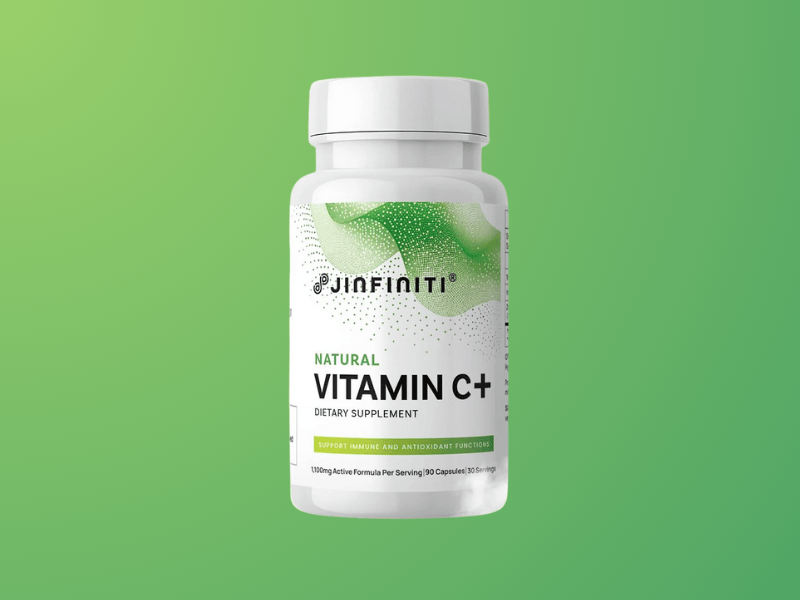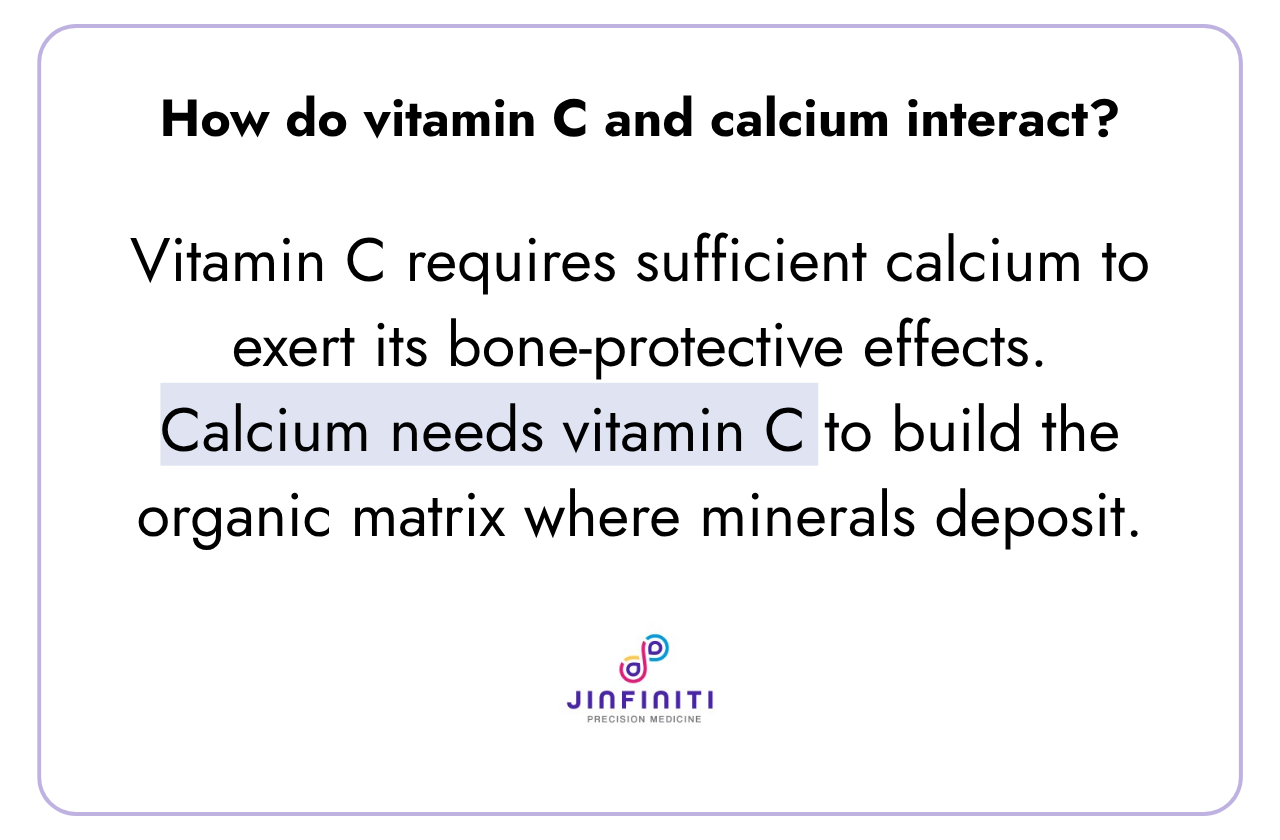
Vitamin C and Calcium: Differences and Interactions
The letter C shows up in both, but vitamin C and calcium couldn’t be more different. One’s a water-soluble vitamin that your body urinates out every day. The other’s a mineral that it stores in your bones for decades.
The letter of the alphabet is the only thing the two have in common, and yet people confuse them all the time. Calcium is what forms the mineral lattice of your skeleton. Vitamin C is what builds the soft scaffolding that holds it all together.
In order to appreciate how the two nutrients work together, it helps to understand how they work separately.
Highlights
- Calcium is a mineral that is stored in our bones and teeth. Vitamin C is a water-soluble vitamin, and must be taken every day because it is not stored in the body.
- Vitamin C has been shown to increase absorption of calcium, and is also required for the production of collagen. Collagen forms the matrix in which calcium minerals are deposited in the bones.
- If you have a deficiency of either nutrient, you can develop some serious health problems, such as scurvy, or osteoporosis.
- The two nutrients are synergistic, and studies have shown that the bone-protective effects of vitamin C are greatest when at least 500 mg of calcium is taken daily.
Vitamin C and Calcium Differences
Vitamin C (ascorbic acid) is a water-soluble vitamin that your body excretes every day in the urine. As such, you must consume it daily, as the body does not produce or store it.
Calcium is a mineral that works in a completely different way from vitamin C. Your body keeps 99% of its calcium in bones and teeth as a reserve to draw from when dietary intake is insufficient to maintain blood levels. Calcium is crucial for hundreds of cell functions. It also makes up 1-2% of your body weight.
Calcium vs. Vitamin C: Functions in the Body
Calcium is the building block of your bones. In fact, it makes up hydroxyapatite crystals in bone and teeth that provide the hardness in them. In addition to helping build and maintain bone, it also helps regulate muscle contraction, nerve impulses, blood vessel health, and hormone release.
Calcium levels are strictly controlled in the body by the parathyroid glands. When blood calcium levels are low, the parathyroid hormone (PTH) is released.
PTH stimulates cells in the bones called osteoclasts to release the calcium they store into the blood. It also signals the kidneys to retain more calcium and activate vitamin D to increase the absorption of calcium in the intestines[1].
On the other hand, vitamin C mainly acts as an antioxidant and cofactor for many enzymes. One of the most important functions of vitamin C is collagen synthesis.
Vitamin C activates two enzymes that are essential for modifying the amino acids that build collagen (prolyl hydroxylase and lysyl hydroxylase). Without this modification, collagen becomes brittle.
The brittleness manifests in the body. Blood vessels begin to leak, wounds do not heal, bones weaken despite normal calcium intake, etc. These are the symptoms of scurvy, a disease caused by vitamin C deficiency[2].

How Do Vitamin C and Calcium Work Together?
Vitamin C’s Role in Calcium Absorption
Vitamin C could also have a positive effect on the retention and utilization of calcium in the body. The detailed mechanisms for this are not well understood. Leichsenring et al. showed an increase in calcium retention from baseline with supplementation of either orange juice or crystalline ascorbic acid[3].
A more recent animal study has confirmed that vitamin C supplementation, in a formulation with calcium from eggshell powder, “significantly increased” the serum calcium levels[4]. Vitamin C is thought to stabilize the calcium and increase its solubility, leading to the improved bioavailability.
The connection between vitamin C and calcium is important for overall bone health as well. Vitamin C-deficient animals have shown to have consistently inhibited bone formation and enhanced bone resorption, while restoration of vitamin C returns markers of bone formation to baseline[5].
The Collagen Connection for Bone Health
Here’s what many people miss: bones aren’t just calcium. They’re composite material combining minerals with an organic protein matrix made almost entirely of collagen.
Vitamin C creates that matrix. Calcium mineralizes it.
Think of bone like reinforced concrete. Calcium provides the hard mineral (like concrete). Collagen provides the flexible framework (like steel rebar). You need both for structural integrity.
“Vitamin C is necessary for proper collagen folding and stability,” explains Dr. Jin-Xiong She, founder of Jinfiniti Precision Medicine. “When vitamin C levels drop, collagen becomes deficient regardless of calcium intake. The organic scaffold weakens, and bones lose their resilience even when mineral content appears adequate on standard tests.”
This explains why vitamin C deficiency causes bone pain and fractures despite normal calcium levels. The mineral foundation crumbles without its protein scaffolding.
Do You Need Both for Strong Bones?
The answer is yes, and the science shows why.
Why Collagen Matters as Much as Minerals
Your bones constantly remodel themselves, breaking down old tissue and building new. Two cell types handle this: osteoclasts dissolve old bone, while osteoblasts build new bone matrix.
Osteoblasts can’t do their job without vitamin C. Studies show that when vitamin C is deficient, osteoblast activity plummets and osteoclast activity increases. The balance tips toward bone loss[6].
One study examining vitamin C concentrations and fracture risk followed adults for 15-17 years[7]. Those with higher total vitamin C intake (around 300 mg daily) showed significantly lower risk of hip and non-vertebral fractures compared to low intake (around 95 mg daily).
Research on Combined Intake
The protective effects of vitamin C on bone appear strongest when calcium intake is adequate. Research on postmenopausal women found that higher dietary vitamin C intake associated with increased bone mineral density at the hip and femoral neck—but only in women consuming at least 500 mg daily of calcium[8].
This highlights how these two nutrients work together. Vitamin C requires sufficient calcium to exert its bone-protective effects. Calcium needs vitamin C to build the organic matrix where minerals deposit.

A unique formulation called calcium ascorbate combines both nutrients. Studies comparing calcium ascorbate to standard ascorbic acid show the calcium component may offer superior gastrointestinal tolerability while providing enhanced immune benefits[9].
One preliminary study found 500 mg of calcium ascorbate promoted greater increases in white blood cell vitamin C concentrations compared to 500 mg of ascorbic acid alone[10]. The calcium appears to buffer ascorbic acid’s acidity, reducing stomach irritation.
What Are the Signs of Deficiency?
Early recognition of deficiency symptoms can prevent serious health problems.
Vitamin C Deficiency Symptoms
About 7% of adults in the United States have vitamin C deficiency. Risk increases with poor diet, alcohol use, smoking, severe mental illness, or dialysis treatment.
Early symptoms emerge after 4-12 weeks of insufficient intake:
- Fatigue and irritability
- Easy bruising and bleeding gums
- Rough, bumpy skin (keratosis pilaris)
- Joint pain and muscle aches
- Slow wound healing
Severe deficiency causes scurvy. Distinctive signs include corkscrew-shaped body hairs, tiny hemorrhages around hair follicles, bleeding gums, and loose teeth. Children may refuse to walk due to bone pain. Left untreated, scurvy can be fatal.
Dr. Harri Hemilä, a leading vitamin C researcher, notes that “given such strong evidence that in certain contexts vitamin C is beneficial against colds, it is baffling that in mainstream medicine the effects of the vitamin are largely ignored.”[11]
Calcium Deficiency Symptoms
Approximately half the world’s population doesn’t get enough calcium from their diet. The global disease burden from low calcium was estimated at 3.14 million disability-adjusted life years in 2019.
Early calcium deficiency may produce no symptoms. Over time, watch for:
- Muscle cramps and spasms
- Numbness and tingling in extremities
- Brittle nails that break easily
- Confusion or memory problems
- Bone fractures from minor trauma
Severe hypocalcemia can cause seizures, abnormal heart rhythms, and death. Long-term deficiency leads to osteopenia and osteoporosis—conditions where bones become porous and fracture easily.
Daily Vitamin C and Calcium Intake
Adults need 75-90 mg daily of vitamin C according to standard recommendations. Women require 75 mg, men 90 mg. Pregnancy increases needs to 85 mg, breastfeeding to 120 mg. Smokers need an extra 35 mg daily due to increased oxidative stress.
The Linus Pauling Institute recommends 400 mg daily for disease prevention in healthy adults. This recommendation accounts for research showing reduced cardiovascular disease risk at this intake level. Plasma vitamin C concentrations become fully saturated at intakes around 400 mg daily.
For calcium, most adults need 1,000-1,200 mg daily. Requirements increase with age, particularly for postmenopausal women. Adolescents need adequate calcium during peak bone formation years to maximize lifelong bone strength.
📋 RELATED READING
- Maximize nutrient benefits? Discover how vitamin C supports digestion and gut health for better nutrient absorption.
- Want stronger cellular foundations? Explore the best supplements for cellular repair and how they work synergistically.
- Concerned about inflammation? Learn about antioxidant supplements for oxidative stress that support overall health.
Can You Take Vitamin C and Calcium Together?
Yes, it is perfectly safe and potentially advantageous to take vitamin c with calcium. Read below for more info on timing and what the research shows about the two nutrients and bone health:
On an empty stomach (30 minutes before eating or 2 hours after) is when your body will absorb vitamin C the most effectively. With that being said, it is perfectly fine (and lessens the chance of stomach upset) to take with food, especially at higher doses.
Calcium carbonate needs stomach acid to be absorbed, so be sure to take with food. Calcium citrate is fine with or without food. Calcium is best absorbed in doses of 500-600 mg or less. So, if you are taking more than this, take 2 or more separate doses throughout the day.
You can get near 100% absorption with up to a 200 mg dose of vitamin C. Above that, it tapers down but the total amount absorbed continues to go up.
Calcium Ascorbate: A Two-in-One Option
Calcium ascorbate provides vitamin C buffered with calcium. This form offers several advantages for people sensitive to ascorbic acid’s acidity.
Research using surface-engineered liposomal calcium ascorbate formulations demonstrated over 7-fold enhancement in oral bioavailability compared to unformulated calcium ascorbate. The formulation significantly improved maximum concentration, time to peak concentration, half-life, and area under the curve[12].
One consideration: calcium ascorbate provides relatively small amounts of calcium. You’d need about 9 grams of calcium ascorbate to get 1,000 mg of calcium (an impractically large dose). Use it primarily as a vitamin C source with some calcium bonus, not as your primary calcium supplement.
Best Food Sources
Obtaining vitamin C and calcium from foods has benefits beyond supplementation with the isolated nutrient.
Top Vitamin C Sources
Citrus fruits get all the attention, but other foods blow them away. The Kakadu plum from Australia tops the list with up to 2,907 mg per 100g (that’s about 30 times more than an orange). Just one plum provides around 480 mg.
Other exceptional sources per serving:
- Acerola cherries: 1,650 mg per half cup
- Amla fruit (indian gooseberry): 300mg per half cup
- Guava: 125 mg per fruit
- Red bell peppers: 95 mg per half cup
- Kiwifruit: 64 mg per fruit
- Strawberries: 49 mg per half cup
- Oranges: 70 mg per medium fruit
- Broccoli (cooked): 51 mg per half cup
Heat degrades vitamin C during cooking. Eat fruits and vegetables raw or lightly steamed to preserve vitamin C content.
Best Calcium-Rich Foods
Dairy products provide highly absorbable calcium efficiently. One cup of milk delivers approximately 300 mg. Yogurt and cheese offer similar amounts.
Non-dairy sources include:
- Fortified plant-based milk alternatives
- Canned sardines or salmon with bones
- Calcium-set tofu
- Fortified orange juice
- Leafy greens (though absorption is lower)
- Fortified cereals
Calcium bioavailability varies dramatically between foods, ranging from less than 10% to over 50%. Dairy products typically provide superior absorption due to casein phosphopeptides, whey proteins, lactose, and other components that work together to enhance passive calcium uptake.
The combination of fortified orange juice gives you both calcium and vitamin C in one glass—a practical way to get both nutrients together.
Do You Need Calcium and Vitamin C Supplements?
Consider supplements when you can’t get enough through diet or you are showing signs of deficiency. However, don’t rely on a guess.
Rule out guesswork with testing. Biomarker tests show your true nutrient levels and reveal if you are low and by how much.
Jinfiniti’s AgingSOS® panels test multiple biomarkers of nutritional status, inflammation, oxidative stress and cellular aging to give you the big picture and address issues before they become clinical disease.
Blood tests can check for serum calcium and vitamin C. Note that serum calcium levels are tightly regulated and may be normal even if you are depleting your bone reserves. Bone mineral density scans are more directly reflective of skeletal calcium.
Optimizing Your Intake
Jinfiniti’s TAO approach—Test, Act, Optimize—applies perfectly to nutrient optimization:
- Test: Measure baseline levels through blood work or comprehensive biomarker panels. Identify specific deficiencies rather than supplementing blindly.
- Act: Implement targeted interventions based on test results. This might include dietary changes, supplementation with specific forms of vitamin C, or addressing absorption issues.
- Optimize: Retest after 3-4 months to verify interventions work. Adjust dosages or approaches based on follow-up results.
Jinfiniti’s Natural Vitamin C + Zinc provides whole food vitamin C from amla extract combined with bioavailable zinc chelate for immune support and antioxidant benefits. Our Vital Minerals Complex offers chelated minerals with enhanced absorption, including calcium citrate in an optimal 2:1 calcium-magnesium ratio.
For comprehensive health assessment, the AgingSOS® Advanced Panel measures 28 biomarkers including rare ones like intracellular NAD+ and Klotho protein. This testing identifies issues years before symptoms appear, allowing early intervention when changes are easiest to make.
Bottom Line
Calcium and vitamin C are different, but complementary vitamins for health. Calcium is the mineral basis for our bones and teeth, with regulating functions in cells. Vitamin C helps produce collagen (the organic matrix where calcium is deposited).
Calcium and vitamin C work better together for skeletal health than individually. Testing your levels, following up, and optimizing based on results means you get what your body needs, rather than guessing.
Referenced Sources
- Khan M, Jose A, Sharma S. Physiology, Parathyroid Hormone. 2020.
- Maxfield L, Crane J. Vitamin C Deficiency. 2020.
- Leichsenring JM, Norris LM, Halbert ML. Effect of Ascorbic Acid and of Orange Juice on Calcium and Phosphorus Metabolism of Women. Elsevier BV; 1957. https://doi.org/10.1093/jn/63.3.425
- Godwin Afiukwa Oche, Osonwa Eke Uduma, Innocent Mary Ifedibaluchukwu Ejiofor. Improvement in bioavailability of ascorbic acid and calcium using eggshell powder. GSC Online Press; 2025. https://doi.org/10.30574/gscbps.2025.30.2.0033
- Blouin S, Khani F, Messmer P, Roschger P, Hartmann MA, van Wijnen AJ, et al. Vitamin C Deficiency Deteriorates Bone Microarchitecture and Mineralization in a Sex-Specific Manner in Adult Mice. Oxford University Press (OUP); 2023. https://doi.org/10.1002/jbmr.4889
- Chin KY, Ima-Nirwana S. Vitamin C and Bone Health: Evidence from Cell, Animal and Human Studies. Bentham Science Publishers Ltd.; 2018. https://doi.org/10.2174/1389450116666150907100838
- Aghajanian P, Hall S, Wongworawat MD, Mohan S. The Roles and Mechanisms of Actions of Vitamin C in Bone: New Developments. Oxford University Press (OUP); 2015. https://doi.org/10.1002/jbmr.2709
- Alabadi B, Civera M, Moreno-Errasquin B, Cruz-Jentoft A. Nutrition-Based Support for Osteoporosis in Postmenopausal Women: A Review of Recent Evidence. Informa UK Limited; 2024. https://doi.org/10.2147/ijwh.s409897
- Calder PC, Kreider RB, McKay DL. Enhanced Vitamin C Delivery: A Systematic Literature Review Assessing the Efficacy and Safety of Alternative Supplement Forms in Healthy Adults. MDPI AG; 2025. https://doi.org/10.3390/nu17020279
- Dickerson B, Gonzalez DE, Sowinski R, Xing D, Leonard M, Kendra J, et al. Comparative Effectiveness of Ascorbic Acid vs. Calcium Ascorbate Ingestion on Pharmacokinetic Profiles and Immune Biomarkers in Healthy Adults: A Preliminary Study. MDPI AG; 2024. https://doi.org/10.3390/nu16193358
- Hemilä H, Chalker E. Bias against Vitamin C in Mainstream Medicine: Examples from Trials of Vitamin C for Infections. MDPI AG; 2022. https://doi.org/10.3390/life12010062
- Joseph A, Kumar D, Balakrishnan A, Shanmughan P, Maliakel B, IM K. Surface-engineered liposomal particles of calcium ascorbate with fenugreek galactomannan enhanced the oral bioavailability of ascorbic acid: a randomized, double-blinded, 3-sequence, crossover study. Royal Society of Chemistry (RSC); 2021. https://doi.org/10.1039/d1ra06483e

Get weekly health insights and exclusive offers by joining our newsletter.










